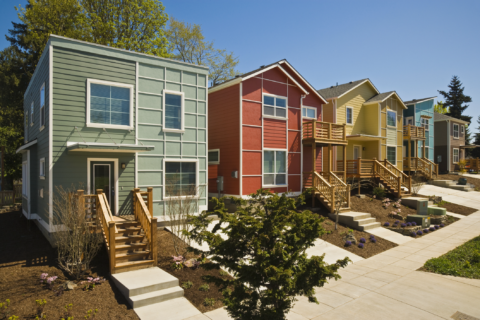Post-secondary students – those pursuing education after high school – often lack access and eligibility for programs that are designed to provide affordable housing and supportive services to those experiencing housing insecurity. In 2020, 48 percent of post-secondary students reported experiencing some form of housing insecurity, while 14 percent reported experiencing homelessness. Student households are not generally eligible to live in affordable housing financed by the Low-Income Housing Tax Credit (LIHTC), which is the largest federal program for producing affordable rental units. Post-secondary students also struggle to access market-rate housing, often lacking the necessary credentials, such as rental history, cosigners, funds to use for a security deposit, etc.
Post-secondary education is becoming increasingly necessary for people to secure employment. The number of jobs requiring education and training beyond high school is expected to increase by 30 percent over the next decade.
Moreover, homelessness amongst post-secondary students is often misunderstood, due to an issue of data quality. The federal government and local Continuums of Care (CoC) collect data regarding homelessness, however local policymakers lack access to such data to grasp the full extent of postsecondary student homelessness. This data gap makes it difficult to create successful targeted policies to remedy homelessness amongst this population.
There are some subpopulations of post-secondary students that are more vulnerable to housing insecurity due to systemic and historic barriers to higher education and housing. At more than 70 percent, rates of basic needs insecurity were highest among Indigenous, Native American, and Black students.LGBTQ+ students, students with disabilities, and students with medical conditions reported higher rates of housing insecurity and homelessness. More than one-third of LGBTQ+ college students experienced housing disruption, particularly through the COVID-19 pandemic. Non-traditional students, particularly students with children, were also at higher risk of housing insecurity. Parenting students make up nearly a quarter of undergraduate students and nearly a third of graduate students, but parenting students complete college at a much lower rate than other students, even though they earn comparable course grades.
Cities Collaborating with Post-Secondary Institutions
Cities and local governments across the country are piloting programs in collaboration with post-secondary institutions to address the housing needs of students. Such housing challenges require innovative solutions, some of which include:
- In Raleigh, NC, the Housing Options for Students Today (HOST) Home Program gives post-secondary students struggling with housing insecurity an opportunity to live with a host family during their studies so they can focus on school while seeking stable housing. HOST is a community-engaged strategy to address the housing needs of post-secondary students without relying on emergency shelters or transitional housing programs. The nature of the program, requiring no infrastructure investment, makes it highly cost effective and scalable.
- In Columbus, OH, the Success Bridge Housing Stabilization Program was created to support students at Columbus State Community College experiencing housing instability, the Success Bridge Housing Stabilization program was developed in collaboration with the Columbus Metropolitan Housing Authority. The program provides campus and community resources to stabilize students through the completion of their degree. Eligibility requirements are based on financial need, academic credit specifications, and require program participants to earn income at or below 200% of the Federal Poverty Guidelines.
- In Philadelphia, PA, the Share Housing Partnership is an income-based housing project developed in collaboration with the Community College of Philadelphia and the Philadelphia Housing Authority. This housing project serves exclusively community college students, providing low-cost apartments for housing insecure students with a focus on those who have experience in the foster care system.
What’s Next for Cities?
As housing costs continue to climb, it is becoming increasingly important for cities to support post-secondary students – an often-overlooked population – in their search for stable affordable housing. Cities may consider developing programs and policies which:
- Foster partnerships and collaboration with local housing authorities and post-secondary institutions to provide financial assistance and housing. Cities should also work to bring together post-secondary institutions with other community-based organizations and service providers to address students’ unmet needs.
- Remove regulatory barriers to housing development near college campuses to increase student housing development. This can include up-zoning campus-adjacent areas for higher density mixed-use development and focusing on multifamily housing projects.
- Develop programs in tandem with colleges to lease unused campus land to private developers to increase housing stock on campus reserved especially for students.
- Increase participation and engagement for post-secondary students in formal decision-making spaces, such as local government and zoning commissions. Amplifying the voices of post-secondary students, particularly those with lived experiences of housing insecurity or homelessness, will hopefully increase awareness of student housing needs.
International Town & Gown Association and National League of Cities Housing Access in Communities Hosting Higher Education Institutions Survey
Take 5 minutes to share insights on housing challenges faced by communities hosting higher education institutions.








